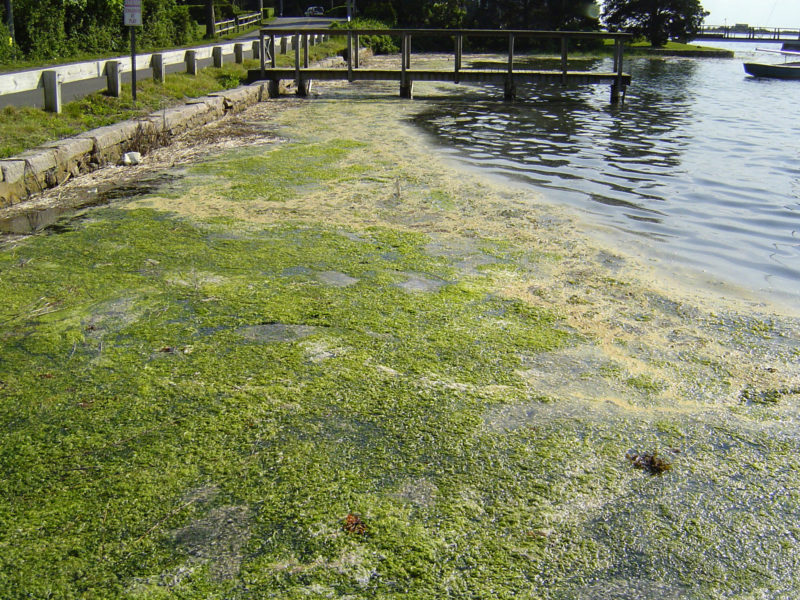Long Island fish kills show harmful effects of nitrogen pollution on our coastal waters
Buzzards Bay’s nitrogen pollution problem is a story we tell often – too much nitrogen in the water fuels the growth of cloudy, murky algae blooms that lead to low oxygen levels and cause eelgrass, bay scallops, and other important species to disappear. Although there are several sources of nitrogen pollution to the Bay, the most harmful one is septic systems.

Nitrogen pollution fuels the growth of algae blooms, like this one seen in West Falmouth Harbor in 2012.
But nitrogen pollution isn’t just happening in Buzzards Bay. Up and down the East Coast, bays and rivers are facing the same crisis. As we’ve written about before, the Chesapeake Bay has been tackling nitrogen and phosphorus pollution for years from wastewater, farms, and polluted stormwater runoff.
Now Long Island’s bays and rivers are suffering from the harmful effects of nitrogen pollution – and for those of us on Buzzards Bay and Cape Cod, this familiar story is a cautionary tale.
A June 5 article from The New York Times illustrates a disturbing scene that local residents witnessed this spring: hundreds of dead turtles and thousands of dead fish washing ashore from waters so polluted with nitrogen that they choke out life.
The dead turtles, about 100 of them, started washing ashore near here in late April. Then came the dead fish, in numbers no one had seen before. By this week, tens of thousands of fish carcasses had bobbed to the surface of the Peconic River, which runs along the southern border of this town, and in adjoining Flanders Bay, washing ashore in putrid drifts.
The waters of the Peconic Estuary, on the East End of Long Island, were coughing up their fauna.
There is little debate about what caused the die-offs. Scientists trace the fish carnage to algal blooms fed by elevated levels of nitrogen, which can be attributed in large part to the region’s outdated septic tanks and cesspools. Evidence suggests that a similar sequence killed the turtles in what scientists said was a highly unusual die-off.
In nearby Great South Bay, an algae bloom called brown tide has popped up again for the third straight year. According to one scientist, the bay has reached a “tipping point” with nitrogen pollution from nearby septic systems and cesspools, which leach nitrogen into the water.
The YouTube ID of BuT_z4G63SA?rel=0 is invalid.Long Island’s coastal waters aren’t very different than Cape Cod’s. Local homes rely on septic systems to treat their wastewater, and most of those systems are old and outdated.
Warm water temperatures make the harmful effects of nitrogen pollution even worse. Although Long Island is south of Buzzards Bay, its waterways are only slightly warmer than ours. And according to scientists with the Woods Hole Oceanographic Institution (WHOI) who are analyzing the Coalition’s long-term monitoring data, Buzzards Bay’s water temperatures are getting warmer.
The bottom line? If temperatures continue to rise and nitrogen pollution doesn’t improve, Cape Cod’s coastal waters could soon look like Long Island’s do now.
The nitrogen pollution crisis is urgent. That’s why the Coalition is continuing to fight to reduce pollution and clean up all of Buzzards Bay’s waterways. We’re also looking to the future: Thanks to a $1 million grant from the MacArthur Foundation, we’re working with WHOI scientists to expand our water monitoring program and investigate the effects of a changing climate.
The good news is that we can make a difference to stop nitrogen pollution and protect clean water in Buzzards Bay and other coastal waterways, even in the face of rising temperatures. Tampa Bay in Florida is clear proof of that. Scientists there recently announced that sea grasses have expanded to healthy levels not seen since the 1950s. This shows that when people work together to reduce pollution, conditions can improve and our waterways can thrive.
If you want to help protect clean water in Buzzards Bay, then sign up to volunteer as a Baywatcher this summer in your community.